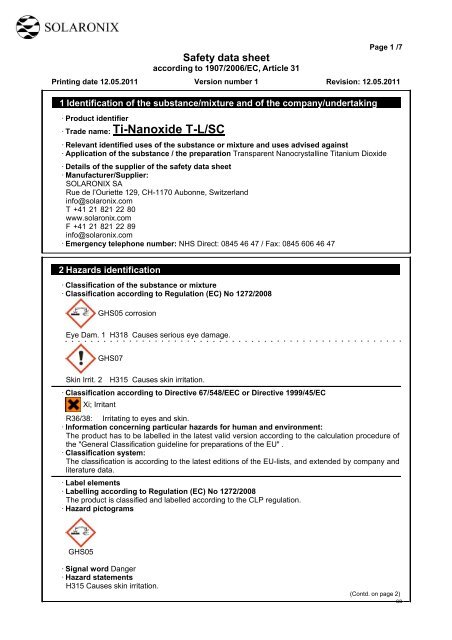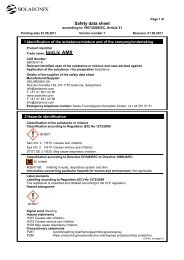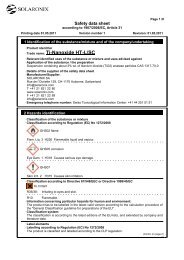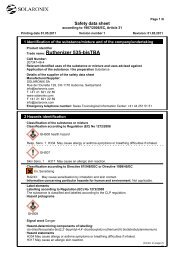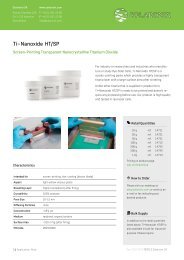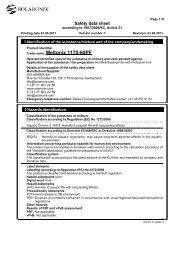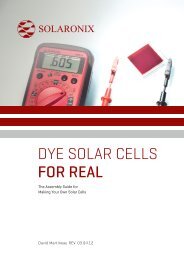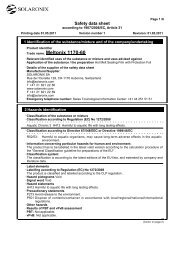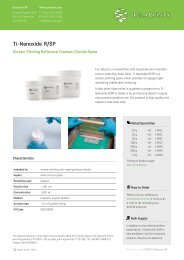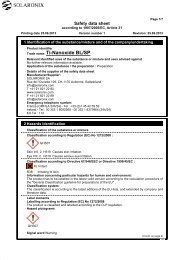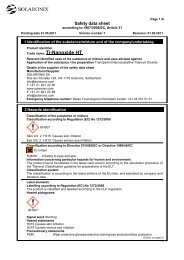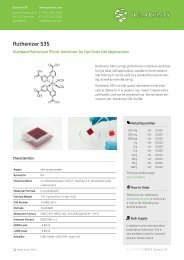MSDS Ti-Nanoxide T-L SC - Solaronix
MSDS Ti-Nanoxide T-L SC - Solaronix
MSDS Ti-Nanoxide T-L SC - Solaronix
Create successful ePaper yourself
Turn your PDF publications into a flip-book with our unique Google optimized e-Paper software.
DRSafety data sheetaccording to 1907/2006/EC, Article 31Page 2 /7Printing date 12.05.2011 Version number 1Revision: 12.05.2011Trade name: <strong>Ti</strong>-<strong>Nanoxide</strong> T-L/<strong>SC</strong>(Contd. of page 1)H318 Causes serious eye damage.· Precautionary statementsP280Wear protective gloves/protective clothing/eye protection/face protection.P305+P351+P338 IF IN EYES: Rinse cautiously with water for several minutes. Remove contactlenses, if present and easy to do. Continue rinsing.P310Immediately call a POISON CENTER or doctor/physician.P321Specific treatment (see on this label).P362Take off contaminated clothing and wash before reuse.P332+P313 If skin irritation occurs: Get medical advice/attention.· Other hazards· Results of PBT and vPvB assessment· PBT: Not applicable.· vPvB: Not applicable.3 Composition/information on ingredients· Chemical characterization: Mixtures· Description:Mixture: consisting of the following components.Suspension containing about 3% wt. of titanium dioxide (<strong>Ti</strong>O2) anatase particles CAS 1317-70-0· Dangerous components:CAS: 64-17-5 ethanol10-25%EINECS: 200-578-6 F R11Flam. Liq. 2, H225CAS: 78989-43-2 Red fuming nitric acid2.5-10%C R35; O R8Ox. Liq. 2, H272; Skin Corr. 1A, H314· Additional information: For the wording of the listed risk phrases, refer to section 16.4 First aid measures· Description of first aid measures· After excessive inhalation:In case of unconsciousness place patient in a stable laying down side position for transportation.· After skin contact: Immediately wash with water and soap and rinse thoroughly.· After eye contact:Rinse opened eye for several minutes under running water. If symptoms persist, consult a doctor.· After swallowing: If symptoms persist consult a doctor.· Information for doctor:· Most important symptoms and effects, both acute and delayedNo further relevant information available.· Indication of any immediate medical attention and special treatment neededNo further relevant information available.5 Firefighting measures· Suitable extinguishing agents:CO2, powder or water spray. Fight larger fires with water spray or alcohol resistant foam.(Contd. on page 3)GB
DRSafety data sheetaccording to 1907/2006/EC, Article 31Page 4 /7Printing date 12.05.2011 Version number 1Revision: 12.05.2011Trade name: <strong>Ti</strong>-<strong>Nanoxide</strong> T-L/<strong>SC</strong>· Protection of hands:(Contd. of page 3)Protective glovesThe glove material has to be impermeable and resistant to the product/ the substance/ thepreparation.· Gloves material :The selection of suitable gloves does not only depend on the material, but also on further marks ofquality which may vary from manufacturer to manufacturer. As the product is a preparation ofseveral substances, the resistance of the glove material can not be calculated in advance and hastherefore to be checked before use.· Eye protection:<strong>Ti</strong>ghtly sealed goggles9 Physical and chemical properties· Information on basic physical and chemical properties· General Information· Appearance:Form:LiquidColour:According to product specification· Odour: Characteristic· Odour threshold: Not determined.· pH-value: Not determined.· Change in conditionMelting point/Melting range:Undetermined.Boiling point/Boiling range: 100°C· Flash point: Not applicable.· Flammability (solid, gaseous): Not applicable.· Ignition temperature: Not applicable.· Decomposition temperature: Not determined.· Self-igniting: Product is not self igniting.· Danger of explosion: Product does not present an explosion hazard.· Explosion limits:Lower:Upper:· Vapour pressure at 20°C: 23 hPaNot determined.Not determined.· Density: Not determined.· Relative density Not determined.· Vapour density Not determined.(Contd. on page 5)GB
DRSafety data sheetaccording to 1907/2006/EC, Article 31Page 5 /7Printing date 12.05.2011 Version number 1Revision: 12.05.2011Trade name: <strong>Ti</strong>-<strong>Nanoxide</strong> T-L/<strong>SC</strong>· Evaporation rate Not determined.· Solubility in / Miscibility withwater:Fully miscible.· Segregation coefficient (n-octanol/water): Not determined.· Viscosity:Dynamic:Not determined.Kinematic:Not determined.· Other information No further relevant information available.(Contd. of page 4)10 Stability and reactivity· Reactivity· Chemical stability· Thermal decomposition / conditions to be avoided:No decomposition if used according to specifications.· Possibility of hazardous reactions No dangerous reactions known.· Conditions to avoid No further relevant information available.· Incompatible materials: No further relevant information available.· Hazardous decomposition products: No dangerous decomposition products known.11 Toxicological information· Information on toxicological effects· Acute toxicity:· Primary irritant effect:· On the skin: Irritant to skin and mucous membranes.· On the eyes: Irritating effect.· Sensitization: No sensitizing effects known.· Additional toxicological information:The product shows the following hasards according to the calculation method of the General EUClassification Guidelines for Preparations as issued in the latest version:Irritant12 Ecological information· Toxicity· Acquatic toxicity: No further relevant information available.· Persistence and degradability No further relevant information available.· Behaviour in environmental systems:· Bioaccumulative potential No further relevant information available.· Mobility in soil No further relevant information available.· Additional ecological information:· General notes:Water hazard class 1 (German Regulation) (Self-assessment): slightly hazardous for water.Do not allow undiluted product or large quantities of it to reach ground water, water course orsewage system.· Results of PBT and vPvB assessment· PBT: Not applicable.(Contd. on page 6)GB
DRSafety data sheetaccording to 1907/2006/EC, Article 31Page 6 /7Printing date 12.05.2011 Version number 1Revision: 12.05.2011Trade name: <strong>Ti</strong>-<strong>Nanoxide</strong> T-L/<strong>SC</strong>· vPvB: Not applicable.· Other adverse effects No further relevant information available.(Contd. of page 5)13 Disposal considerations· Waste treatment methods· RecommendationMust not be disposed of together with household garbage. Do not allow product to reachsewage system.· Uncleaned packaging:· Recommendation: Disposal must be made according to official regulations.· Recommended cleansing agents: Water, if necessary together with cleansing agents.14 Transport information· Land transport ADR/RID (cross-border) :· ADR/RID class: -· Maritime transport IMDG:· IMDG Class: -· Marine pollutant: No· Air transport ICAO-TI and IATA-DGR:· ICAO/IATA Class: -· UN "Model Regulation": -· Special precautions for user Not applicable.· Transport in bulk according to Annex II of MARPOL73/78 and the IBC Code Not applicable.15 Regulatory information· Chemical safety assessment: A Chemical Safety Assessment has not been carried out.16 Other informationThis information is based on our present knowledge. However, this shall not constitute a guaranteefor any specific product features and shall not establish a legally valid contractual relationship.· Relevant phrasesH225 Highly flammable liquid and vapour.H272 May intensify fire; oxidiser.H314 Causes severe skin burns and eye damage.R11 Highly flammable.R35 Causes severe burns.R8 Contact with combustible material may cause fire.· Abbreviations and acronyms:ADR: Accord européen sur le transport des marchandises dangereuses par Route (European Agreement concerning theInternational Carriage of Dangerous Goods by Road)(Contd. on page 7)GB
DRSafety data sheetaccording to 1907/2006/EC, Article 31Page 7 /7Printing date 12.05.2011 Version number 1Revision: 12.05.2011Trade name: <strong>Ti</strong>-<strong>Nanoxide</strong> T-L/<strong>SC</strong>(Contd. of page 6)RID: Règlement international concernant le transport des marchandises dangereuses par chemin de fer (RegulationsConcerning the International Transport of Dangerous Goods by Rail)IMDG: International Maritime Code for Dangerous GoodsIATA: International Air Transport AssociationIATA-DGR: Dangerous Goods Regulations by the "International Air Transport Association" (IATA)ICAO: International Civil Aviation OrganizationICAO-TI: Technical Instructions by the "International Civil Aviation Organization" (ICAO)GHS: Globally Harmonized System of Classification and Labelling of ChemicalsGB


